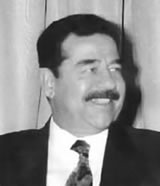|
From FirstStrikeNuts.com First-Strike Fiascos
Saddam’s plan came unraveled. He may still wonder what went wrong. During the 1980s, the US government under Presidents Regan and Bush supported Saddam in his eight-year war with Iran, providing his government with, among other things, frequent satellite battlefield photographs. Moreover, Saddam knew that the US did not act militarily against Iran when they overran the Tehran embassy in 1979, holding captive some seventy Americans for 444 days. Nor did the US act militarily in 1983, when the US Marine barracks in Beirut, Lebanon, was destroyed, resulting in 241 dead marines and more than 100 wounded. For additional assurance, with his army massed along their Kuwait border, Saddam inquired of the US ambassador to Iraq what posture the US government would take concerning Iraq’s border dispute with Kuwait. The US government’s transcript of that conversation is not released, but the New York Times reported that she answered, in part, “…we have no opinion on the Arab-Arab conflicts, like your border disagreement with Kuwait...” Sensing no powerful opposition to Iraq’s long-standing goal of annexing oil-rich Kuwait, Saddam moved swiftly to occupy their neighbor. Margaret Thatcher, for one, and the royal family of Saudi Arabia, for another, were eager to deny Saddam’s aggression. The rich Saudi oilfields bordered Kuwait. Would that be Saddam’s next target for annexation? President Bush remained patient. First, he dispatched senior civilian and military officials to Riyadh for discussions with the Saudi leadership. A deal was struck. The Saudi government would “spring for the bill,” and the US military, combined with UN coalition forces, would drive Iraq from Kuwait. Bush next secured UN approval for this action and through nation-by-nation diplomacy organized a thirty-two nation coalition to oust Saddam from Kuwait. Some nations were offered monetary consideration for their cooperation. For instance, Egypt received debt relief of more than $6 billion from the US government. Finally, after having gained UN approval and having garnered a considerable coalition, President Bush, the elder, sought and obtained approval from the US Senate for the military action to follow. On January 16, 1991, after Saddam’s refusal to abandon Kuwait, the Gulf War began with five weeks of air and missile bombardment, followed by a swift ground campaign. After a mere one-hundred hours of ground combat, the US led coalition ceased fighting, having thoroughly routed the Iraqi forces and driven them from Kuwait. That was the UN mandate. That’s what the Saudi government agreed to pay for. That is what the nations of the coalition agreed upon. Subsequently, Saddam dispatched his generals to surrender, instructing them to submit to whatever terms were required. Saddam’s grand plan for Iraqi expansion was thwarted. His “first-strike adventure” proved so successful that the world could not allow it to stand. He had set a new standard for boldness, one that threatened control of the world’s oil supply. None of the oil consuming nations trusted Iraq with such overwhelming command of oil resources. Neither did Iraq’s neighbors trust her to possess such power and sway over the affairs of their region. Iraq was isolated. She had few, if any, friends. One might argue that isolation, such as this, results directly from Iraq's unilateral, first-strike adventurism. Published previously in an earlier website, July 4, 2003. XXX © Copyright by FirstStrikeNuts.com |
